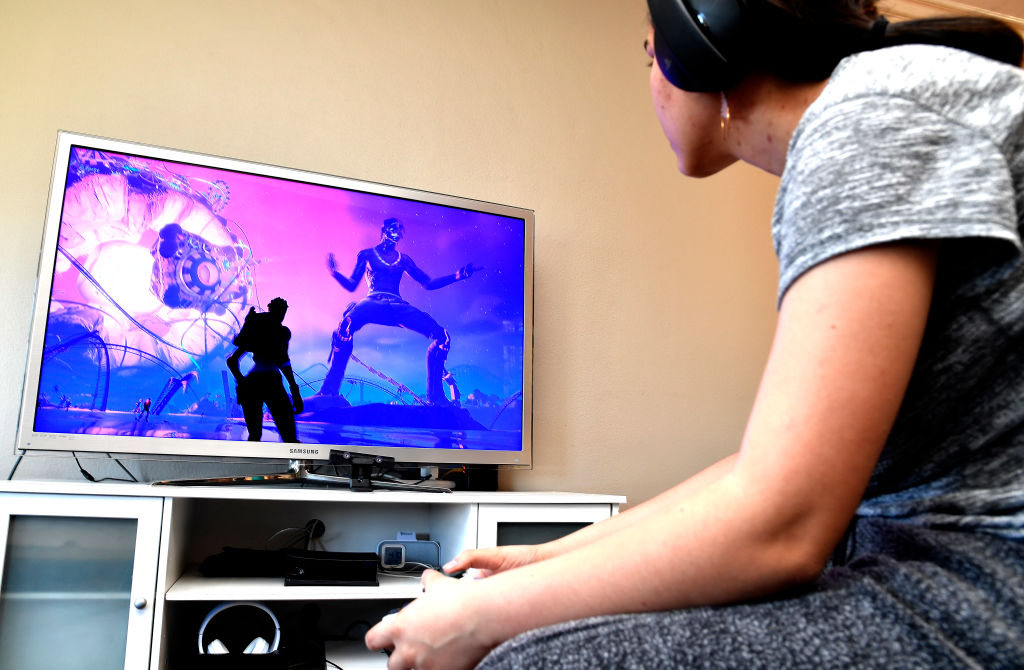Games Like ‘Fortnite’ and ‘Minecraft’ Helped Some Kids Survive Pandemic Boredom. Could They Also Help Counter STEM Learning Loss?
These summer camps are counting on it.
By Greg Toppo | August 16, 2021Sticky problems abound in education these days, but one recent afternoon as teacher Nathan Finley walked students through the latest level of a new, original maze-like video game they were designing, a particular problem loomed large.
Finley couldn’t get the level to end.
“We just now created our ‘end object,’” he narrated over Zoom to the class, explaining that if a player’s avatar, working its way through the maze, collides with this invisible digital item, it should prompt the computer to display a “You Win” message, end the level, and send the player on to the next one.
“So far, it still isn’t working,” Finley said cheerfully, alternately checking lines of code and clicking on objects populating the screen. Perhaps it was the code they’d written together, or something else. “So we need to figure out what’s going on here.”
While millions of kids play video games, few get a peek inside the detail-driven and frequently maddening process of creating games. But this summer, as educators puzzle over how to help students catch up on months of disrupted learning due to COVID-19, many are pushing to teach key STEM concepts via game design.
The idea has obvious advantages, supporters say: Kids already love games and spend hours playing and discussing them, so they’re highly motivated to learn the required material. And cracking games’ code open — whether to examine how it works, design new levels or create entirely new games — enables them to do rigorous math, logic, and design work they don’t often get in school.
“I like to say we’re giving kids the tools that they need to lead successful lives in the digital age — and preparing them for the coming of the metaverse,” said Ed Fleming, founder of a long-running computer camp based in Philadelphia. The metaverse, a term coined by science-fiction novelist Neal Stephenson, refers to an all-encompassing 3-D digital space that resembles those of today’s massive multiplayer games.

Fleming remembers where he was when he first understood the gravity of COVID-19. While attending an educational trade show in Philadelphia in February 2020, a colleague mentioned that the virus had just forced schools in Japan to close. “I told my colleagues, ‘This is going to come to the United States. We have to prepare for this coming summer.’”
He began preparing to move his camp sessions online, where they remain, for the second summer in a row. Sessions run from $169.99 to $249.99 but Fleming offers about 100 scholarships each year to low-income campers.
It may seem ironic that some educators see the solution to online learning loss as more online learning, but both Fleming and his students say the experience is different. Game design and other technology-related topics, they say, translate well to online spaces like Zoom.

Savana Wanex, a rising eighth-grader and “a big gamer” in Orlando, Fla., said the camp’s online classes were actually an improvement over those of her private middle school.
“I was actually surprised at how much better it was than taking school online,” she said. Since most of the classwork is in game design and related fields, “you can team up with other people in games and work side-by-side with them, kind of like you’re close to them.”
She attended school almost entirely in-person last year, spending only a few weeks of class time online due to a short-term quarantine after a classmate tested positive for the virus. But Savana admitted, “Digital school is very hard.” The larger difficulty, she said, lay in wearing masks all day and maintaining six feet of social distance between herself and others.

“It’s just been a really weird year because you haven’t really been able to do those big group projects — you can’t really get together.”
Now in its 19th year, Fleming’s camp actually goes beyond simple maze games like the one that Nathan Finley and his students puzzled over. Aimed at students as young as second graders and as old as high school seniors, it offers lessons in computer coding and game design, but also in the visual arts and digital video, as well as more esoteric topics such as the Physics of Amusement Parks — all subjects required to build a complete and satisfying 3-D game.
The camp also invites students to create original content using advanced software routinely used by professional game designers, making the experience “a great introduction to computer science,” said longtime game design teacher Steve Isaacs. “There’s the art piece, the sound engineering piece. It’s such a cross-curricular area. And again, kids love games, so why not capitalize on their agency in that area?”
Recent statistics from the Entertainment Software Association, the trade organization for the video game industry, suggest that gaming remains popular among young people, even as other entertainment forms such as streaming movies and social media abound. About three-fourths of people under 18 play video games weekly — though the average player is 31 years old — and nearly half of gamers are female.
Fleming started the camp in 2003, with about 200 students — only one of them a girl, he noted. Now girls comprise about 40 percent of his 1,300 campers. In fact, two recent sessions — one focused on the building game Roblox and another on digital fashion design — were attended only by girls.
Not just consuming but creating
A lifelong gamer, Fleming can trace the growth of his camp to his grad student days teaching e-commerce at Penn State University Great Valley, a remote campus west of Philadelphia. When the dot.com bubble burst, the university found itself with six classrooms of computers, but no students.
Fleming suggested bringing younger students onto campus to design games and applications.
The program started out teaching students the basics of tools like the since-discontinued Macromedia Flash from Adobe. It now routinely puts students through the paces of working in Unreal Engine, the software used to create Fortnite.
“I grew up with Atari joysticks,” Fleming said. “And now the kids are growing up having the monolith in their hand and access to everything you could ever imagine.” He held up a glass-slab mobile phone to illustrate his point. “We just give them the tools to actually make that monolith do things that they want it to do.”
Dave Kramer, who has taught at the camp, and whose 13-year-old son Aiden attends it, said creating media, not just consuming it, was a huge motivation. The boy was eager to attend once he understood that “you can be the person making those videos or making those games … instead of you just watching someone playing someone’s game. That really did intrigue him.”
But after a year of remote schooling, he was reluctant to place the boy into a summer program built around Zoom sessions and computer programming. “My concern was too much screen time,” he said. “And how we worked that out was once you got off of school or camp, then there was no other screen time pretty much for the rest of the day, except for earned time.”
He said the program has “actually worked out very, very well” for Aiden, who loves video games, movies, and YouTube videos. “He loves Fortnite, he loves Minecraft — you know, typical 13 year old.”
A creative “sandbox” leads the way
Epic Games, creators of the wildly popular Fortnite series, actually built the first version of Unreal Engine in 1998, and it has since become highly influential in game design circles.
Epic Games’ Isaacs, himself a former special education and technology teacher, transitioned into the game design world from K-12 education. He and his wife, also a teacher, opened a computer training and gaming center that offered afterschool and summer programs. Eventually he persuaded his New Jersey school district to let him offer game design to middle schoolers in Basking Ridge, N.J., west of Newark.
Isaacs wrote the curriculum and built a program that offered not just game design but digital storytelling, and focused on iterative design, a process used in many areas that emphasizes improving on previous versions of a product.

“My feeling was (that) I was providing an opportunity for kids to find their passion,” he said. “There are so many different roles in the game design industry. I think it’s neat for kids to start to understand that there are different options that they can pursue.”
In 2018, Epic Games released a “sandbox” version of Fortnite that allows players to modify the game’s features and create their own “islands,” mini-games, and other assets.
Isaacs, a serial education entrepreneur who has also produced content for Minefaire, a massive Minecraft “fan experience,” saw an opportunity for educators. Last year, after more than two decades in the classroom, he retired and now is part of a team at Epic that trains teachers on how to use Fortnite and its underlying engine for learning.

Fleming’s camp is using the Epic curriculum, even as the founder himself worries about what the Delta variant of COVID-19 holds for students in the fall.
“I definitely feel for this generation of kids,” he said. “I’ve tried to provide a platform for them to connect and engage and have fun while also learning.”
Thora Hicks, a rising eighth-grader in Pennsylvania, said she and a fellow camper at a previous session of Fleming’s camp became close friends playing and experimenting with the adventure “sandbox” game Terraria. “And we’re still friends online to this day.”

Hicks, who admitted she’s “really interested in YouTube horror stuff,” said people unfamiliar with virtual worlds like Roblox and Minecraft may not know the platforms make it easy to explore interests and make friends. “I mean, there’s more stuff to do than IRL [in real life]. It’s kind of like an enhancement of the real world — you’re allowed to have fun and to meet new people and just have a good, fun time with people from all over the world. And it’s an easier way to find people with the same interests as you.”
Kramer, whose son Aiden attends the camp, said Fleming’s program works because his instructors are leveraging kids’ love of games and “showing them that there’s math and science in there, along with art and storytelling and creative writing — all these aspects that they might struggle with in school, they’re now finding that avenue to get them interested in all of those things.”
Get stories like these delivered straight to your inbox. Sign up for The 74 Newsletter

